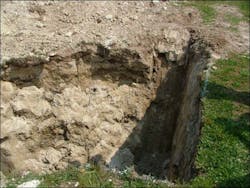In the past, workers and would-be rescuers have become caught and, in some cases, killed needlessly in trenches that have collapsed suddenly, and with little to no warning.
It has become commonplace that the public relies a great deal on the local emergency services to handle these incidents. With that in mind, this month we prepare a safe and efficient response.
A trench can be defined as a temporary excavation in which the length of the bottom of the trench exceeds the width of the floor, and the depth of the trench is greater than the width of the floor.
For ease of nomenclature, many teams identify an excavation as a hole where the floor's width is much greater than the actual depth of the trench. While there are differences with each, both can be very dangerous situations to deal with.
Trenches are made up of five main parts -- the lip, or the top two feet of the wall; the belly, or center of the wall; the toe, or bottom two feet of the wall; the wall, which is comprised of the lip, belly, and toe; and the floor, also known as the base of the trench.
It is important to identify the parts of the trench during the incident, as each part's involvement in the collapse can offer various problems with dealing with the stability of the trench (see Photo 1).
There are many reasons that trenches are dug, including storm drains, sanitary lines, utility services and repair, and roadway renovation and repair. While their purpose will vary, there are some safety standards that have to be addressed while the trench is open:
- Any excavation or trench greater than five feet in depth must be shored.
- Excavation of a material to a level no greater than two feet below the bottom of the support system will be permitted.
- Excavated material (also known as the spoil pile) shall not be piled any closer than two feet of the lip of the trench ( Photo 2).
- Personnel shall be protected from the hazards of cave-in while entering, working in, and exiting the trench (Photo 3).
- Personnel are not permitted in shields or trench boxes while they are being installed, removed, or moved vertically.
- In trenches less than five feet, shoring may be required if examination of the hole by a competent person suggests a potential collapse situation; vibration from road traffic or machinery can cause a cave-in; the trench has been open for an extended period of time (24 hours); or the trench runs parallel within two feet of a roadway or second open trench.
For a complete list of regulations regarding trenches, familiarize yourself with OSHA Regulations regarding trenches, mainly 1926.650; 1926.651; 1926.652; 1926, subpart P, appendices A, B, C, D, and F. Print out copies of these regulations and carry them on your apparatus; they make great reference materials.
When dealing with trenches, it is important to identify the type of soil involved in the incident to assist in determining the equipment needed to safely shore the trench. OSHA has defined four soil categories:
Stable rock is a natural solid material that can be excavated, but it will remain somewhat intact when exposed to the elements. It has the ability to sustain vertical walls up to 90 degrees. This type of material usually requires the aid of a blasting agent to assist in digging in these areas.
The next soils that provide the most stability are referred to as Class A Soils. These soils have an unconfined compressive strength (the load per unit area {square foot} at which a soil will fail under compression load) of at least 1.5 tons per square foot. Examples of these types would include strong clay that has not been dried out, cemented soils, hardpan soils, and clay loam.
Class B Soils provide a lower level of stability. These soils have an unconfined compressive strength of .5 to 1.5 tons per square foot. It is not uncommon for water to be seeping from the trench walls in this type of soil. These include weak clay soils, dried out unstable rock, previously disturbed soil and granular cohesive soils.
Class C Soils are the least stable type of soil. These types have an unconfined compressive strength of less than .5 tons per square foot. Sandy granular soils, submerged soils, and weak clays make up this category (see Photo 4).
There are a couple of ways to identify the type of soil you are dealing with at the incident. One way is the use of a pocket pentrometer, a small measuring device that classifies soils in terms of consistency. A small diameter shaft is pushed into the soil and the amount of resistance of the force applied is marked on a scale measured in tons per square foot (TSF). There are also a few manual tests that one can perform to help identify the type of soil in a trench:
- Plasticity test: Mold a moist or damp sample of soil into a ball and attempt to roll it into threads of soil, approximately the thickness of a pencil. If at least a two-inch length of soil is attained without breaking, then the soil is considered cohesive.
- Dry Strength test: If the soil is dry and crumbles on its own or with little pressure, then it can be considered unstable. But if the soil breaks into clumps that are difficult to break, then the soil is considered cohesive.
- Thumb Penetration test: Take a sample from the top of the spoil pile, which would represent the bottom of the trench, and take a second sample from the bottom of the spoil pile, which would represent the top level of the trench. Take both samples and roll them into a ball. Try to impress your thumb into each ball to see how difficult it is to break the sample apart. If the thumb easily penetrates, then the soil is considered unstable; but if it takes great effort to penetrate the soil with your thumb, then the soil is considered cohesive.
It should be noted, however, that no matter the soil identified that the emergency services find upon arrival to the collapse, keep in mind that the soil did indeed collapse. Therefore, it is wise to classify this as Class C Soil.
The trench can collapse at any time without any warning whatsoever. During the collapse, soil that is falling from a height of only ten feet can fall at 17 miles per hour, trapping the victims without any time to react.
Soil weighs approximately 100 pounds per cubic foot so a victim with a cubic yard of soil on top of them can be pinned under approximately 3,000 pounds of soil. When the soil surrounds the victim and compresses the chest, breathing becomes an impossible task. The crushing weight leads them to suffocate due to the inability of the thoracic cavity to expand to intake any air.
There are many factors that influence a trench collapse, and the most common being the lack of any shoring or protective systems in place prior to the incident. With that being said, when emergency responders arrive, they can expect to install some sort of shoring system during the rescue or recovery (see Photo 5).
Shocks and vibrations are also common reasons for trench collapses. Moving traffic, heavy equipment, and pile driving are all sources of vibrations that can affect the cohesiveness of soil and cause the trench walls to fail.
Intersecting trenches are extremely vulnerable to collapse. Soil has a natural tendency to compress upon itself once there is a space between the soil, it has nothing to compress against. The point that is formed by the two intersecting trenches needs to be properly protected or a large wedge of soil can break off and fall into the intersection (see Photo 6).
Water can affect the cohesiveness of any soil. Too much water will not allow the soil to stick together, and weakens the mass, allowing movement.
The addition of rain water on top of a spoil pile that is serving as a surcharge load near the lip of a trench can add considerable weight to the pile, causing a catastrophic failure of the trench wall. Identifying water pooling at the bottom of a trench or seeping through the walls would immediately classify this soil as Class C (see Photo 7).
Conclusion
As with any emergency incident, a vital part of the success on-scene relies on recognizing the hazards the responders face, and taking appropriate measures to minimize the risk that they pose.
A trench collapse is an extreme example of these risks -- the scene is dynamic, and can change in an instant without any warning.
Taking the time to identify these hazards and characteristics prior to rushing into the incident will aid in the successful remediation of the emergency. Next month we will look at sizing up the incident, safely shoring the trench, and support procedures that are critical to the operation.
Until next time, stay focused and stay safe.
MICHAEL P. DALEY is a lieutenant and training officer with the Monroe Township, NJ, Fire District No. 3, and is an instructor with the Middlesex County Fire Academy, where he is responsible for rescue training curriculum development. Mike has an extensive background in fire service operations and holds degrees in business management and public safety administration. Mike serves as a rescue officer with the New Jersey Urban Search and Rescue Task Force 1 and is a managing member for Fire Service Performance Concepts, a consultant group that provides assistance and support to fire departments with their training programs and course development. Mike was a panelist on Radio@Firehouse on the Successful Rescue Operations in Today's Fire Service. You can reach Michael by e-mail at [email protected].
About the Author

Michael Daley
MICHAEL DALEY, who is a Firehouse contributing editor, recently retired as a 37-year veteran who served as a captain and department training officer in Monroe Township, NJ. He is a staff instructor at multiple New Jersey fire academies and is an adjunct professor in the Fire Science Program at Middlesex County College. Daley is a nationally known instructor who has presented at multiple conferences, including Firehouse Expo and Firehouse World. His education includes accreditations as a Chief Training Officer and a Fire Investigator, and he completed the Craftsman Level of education with Project Kill the Flashover. Daley is a member of the Institution of Fire Engineers and a FEMA Instructor and Rescue Officer with NJ Urban Search and Rescue Task Force 1. He operates Fire Service Performance Concepts, which is a training and research firm that delivers and develops training courses in many fire service competencies.
